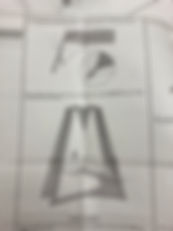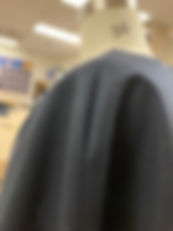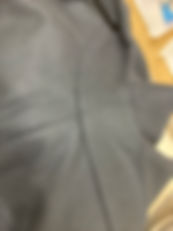Cape Documentation
February 8, 2022:

I began cutting the cape out of the fashion fabric immediately because of our experience with this cape pattern last semester. Using that prior experience we knew that the pattern would fit the actor and using a light wool would drape nicely in this pattern.
February 17:


Continued cutting out more pieces of the cape. During the cutting process I kept adjusting where each pattern piece lay on the fabric to minimize any fabric waste between pattern pieces.
February 21:
Continued cutting out fabric, spent my time today cutting out all the rest of the pattern pieces from the fashion fabric, ready to start moving on to the next stage of construction next.



February 22:
The first step after cutting all the pieces out according to the pattern instructions is to turn all the raw edges over, except for the neckline, by 1/4″ of an inch. This was the first time I got to use a clapper to shape wool. Like cotton, wool is pressed to hold a shape with steam and pressure, but unlike cotton, a tailors clapper is required to really lock in a crease in wool, it’s also good practice to use a pressing cloth so that the wool doesn’t take a shine from pressing. The first picture below shows me just using a pressing cloth and iron to fold the wool over 1/4″. As you can see the wool didn’t keep the crease I wanted it to. At this point Marilyn recommended I use a clapper to make the wool hold its shape, and Kevin recommended because of how light the wool is I didn’t need to beat the crease into shape, but a gentle pressure should be enough. After the first time I used the clapper I couldn’t believe how well it worked. In the second row of photos you can see the corners of two different pattern pieces, the corner on the right was pressed using a clapper, while the corner below was just with an iron. I still find it incredible that using steam and a piece of wood as a mallet is the best way to make wool hold its shape.









With the raw edges turned over the next step is to miter the corners and turn the edges to the inside for finishing. I traced the mitered corner seams from the patter paper but they didn’t seem to line up correctly, so I tried marking my own mitered corner stitching lines. Unfortunately my miter lines weren’t accurate so I had to remove the stitching and redraw one of the lines again. I had already cut the excess bulk fabric from inside the seam so I didn’t have a lot of leeway for my fixed corners which was slightly stressful. In the third row of pictures you can see me sewing the correct mitered corner seam on the second edge of the cape back that I hadn’t removed the stitching from yet. As you can see I had the needle set all the way to the left and had the old stitching line lined up with the center of the sewing foot. Thankfully my moving the miter seam over by 1/8″ was enough to correctly miter the corners and i’m very proud of how crisp they turned out.









With the corners mitered correctly and turned over to the inside, my next step was to press the interior edges flat and pinned to prepare the cape for the top stitching to secure the edges to the cape. The hardest part of this step was pressing and pinning the shoulder edges to the cape. The turned edges of the cape slopes in towards the finished edge of the garment as it nears the shoulders, which makes it a little more involved of a pinning process.





With the edges of the cape body pinned and pressed, now I had to baste the edges together to prevent any slipping of the fabric while I top stitched the turned edge to the cape. For the basting I tried a couple different combinations of needle and thread before settling on a fairly long needle with doubled thread for added strength. With the edges basted I began top stitching as close to the edge as possible, and I’m pretty pleased with how close I followed the edge and the stitching on the mitered corners that I turned.









With the facing secured and the pins removed, I put the cape body on a mannequin to observe my handiwork and the first thing I noticed was that the wool wasn’t draping quite right and looked too wavy at some parts of the top stitching. Thankfully from my experience pressing the raw edges under and remembering Kevin and Marilyn’s advice I knew that wool was a very forgiving fabric when pressed and I found I had fantastic results pressing all the waviness out of the cape. As shown in the photos below.












February 24:
Next I began working on the top stitching for the capelets to attach to the cape body. Thankfully because of my experience with mitering the corners of the cape body, I was able to successfully miter the capelet corners and top stitch them down pretty easily. I had the fitting with the actor in the afternoon but wasn’t able to attach the capelets in time, but since the cape body was complete I was able to test that fit on him and even unfinished the cape gave the actor a very imposing presence. I’m happy that the cape was able to enhance the actors stage presence so.






With the capelets ready, I pinned and basted them to the shoulder seams, matching up the shoulders. The basting helped a lot with preventing puckers and going slowly over all the fabric and adjusting everything every couple of stitched helped me prevent any puckers from forming on my stitching line. In the middle picture in the second row below you can see that the capelets poke out a little from the back, I didn’t realize this until it was pointed out to me later but this would have been the perfect time to inspect how the capelet draped and fix any lingering issues with how it’s positioned on the cape. With everything but the neckline facing finished I took out all the basting stitches and pressed everything flat and crisp and kept it that way with the tailors clapper. Once everything was ironed but before working on the neckband, I had to try the cape on and see how it looked almost completed. To be honest I can see why people wore capes all the time I felt like a badass posing in the mirror as you can see below.























With the rest of the cape finished all that was left to do was create the neckband and attach it to the cape. The neckband was pretty simple I just created two copies of it, turned the inner edges up on one of the copies, sewed them together and then attached the unturned edge to the cape edge. Then I just needed to turn the neckband to the inside and slip stitch the turned edge down to the cape body. I got all the way to pinning the neckband onto the cape until it got too late and I called it a night then.







February 25:
Attached facing strip to cape, no pucker very pleased with my stitching. Pressed facing flat to help give body and structure to cape front opening. pinned interior, turned facing to wrong side of cape for pressing and slipstitching to hide raw edges. Basted and then slipstitched interior facing to cape for a professional finish.
With the neckband pinned to the cape I then basted the two together to make absolutely certain that the fabric wouldn’t shift unexpectedly. I then stitched the pieces together very slowly and kept checking every layer of the cape to make certain that no part of the cape was puckering at the stitching line. My patience paid off and the seam turned out beautifully smooth and pucker-free. After ironing and pinning the inner neckband to the cape, I basted the inner neckband once again to the cape for the final slip stitching. I tried a couple needles for the slip stitching again and ended up preferring a shorter needle for quickly and accurately making the slip stitch. After stitching the neckband down I removed the basting stitches and ironed the neckband flat as you can see in the last couple of pictures.




















Conclusion and Assessment:
I’m proud of my work on this cape. Aside from how the capelets poke out on the back of the cape I think everything else in this garment turned out perfect. This was a successful garment that accomplished the vision of the costume designer. Onstage the cape did exactly what the designer wanted it to do, it provided the actor playing Caesar with the imposing and powerful silhouette required to sell such a performance. I was impressed with how good it looked onstage when I watched the production.

